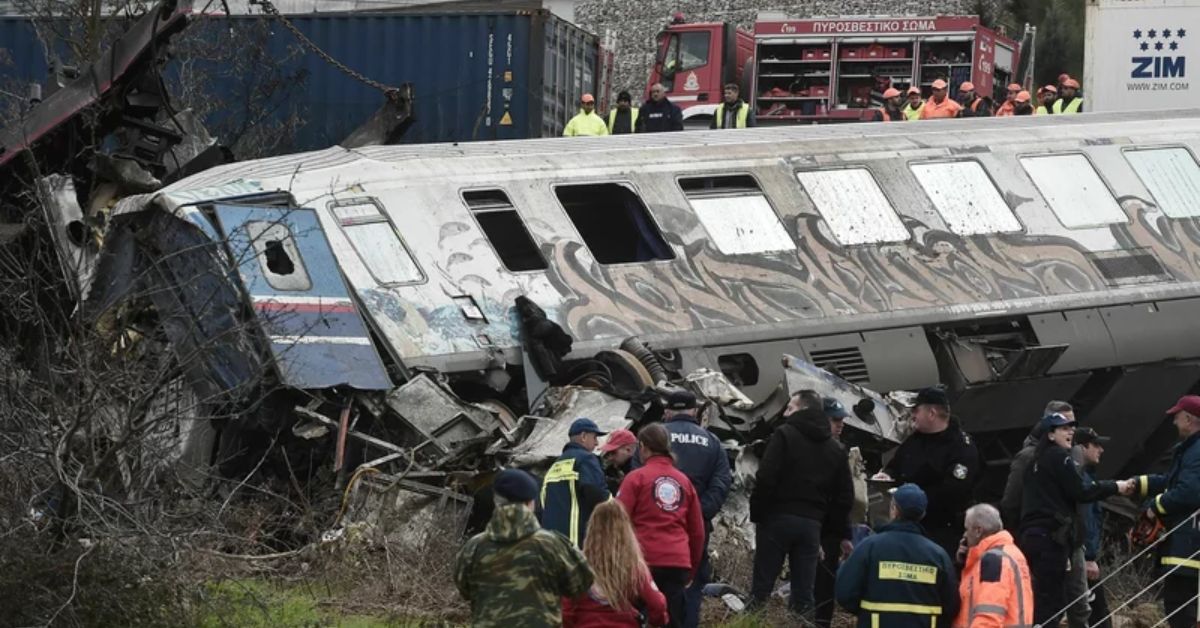Local authorities in Greece report that a passenger and freight train collided on Tuesday night (local time), causing at least 36 fatalities and 66 hospitalisations. The scene from Wednesday morning’s photos and video showed rescuers still searching for survivors through the twisted debris,
After a significant train derailed in Ohio earlier last month, investigators started focusing on a question that had become a common refrain in American media by midday as hope for a resolution faded. What led to this collision?
Below is a summary of everything we know so far.
What Caused the Trains to Crash?
The passenger train, speeding from Athens to Thessaloniki, the second-largest city in Greece at the time of the incident, was carrying about 350 passengers, according to the national rail operator.
According to The Associated Press, many of those passengers were students going home after Carnival, a three-day celebration before the observance of Lent. According to ERT, the public broadcasting service of Greece, the freight train was probably transporting building supplies like big steel plates.

Although appearing to be on a double-track line, both trains seemed to be running in the same direction and on the same track. Just before midnight local time, when the passenger train was coming out of a tunnel beneath a motorway in Tempe, the two trains crashed head-on.
The first two cars of the passenger train were launched, soaring into the air, spinning backward, and catching fire, leaving them destroyed by morning, according to local media accounts quoting survivors. Several confused passengers were forced to flee into the night when the last row of carriages gave way and slid off the tracks.
We have reviewed some top articles on crashes and incidents near you. If you want to read more, follow the links:
- Greek Prime Minister Pledged To Investigate Tragic Greece Train Crash
- 1 Killed, 3 Injured, Including a Toddler, After a Horrific 2-car Crash in North Hollywood
- At least 2 Died and 5 Injured in High-speed Car Crash in Rio Bravo
How Many People Have Died?
Rescue personnel was still combing through the pile of metal early on Wednesday morning, looking for signs of life.
According to Vassilis Varthakogiannis, the Greek Fire Service spokesman, more than 150 firefighters and paramedics are on the scene. Some of the most significant pieces of steel are being moved by the employees with the assistance of cranes and construction tools.
According to Varthakogiannis, most crash survivors were transported by bus to Thessaloniki, where police took names to find the missing.
According to ERT, who cited several government sources, more than 66 people were taken to the hospital, and as of Wednesday, at least six were still receiving intensive care. There were 130 injuries in total.
The ERT also stated that the 36 confirmed fatalities are rising as more victims are located. This task has proven challenging due to the high temperatures at which the first three carriages caught fire.
According to the prime minister, Greece will observe three days of national mourning.
What Do We Understand About the Root Cause?
According to a statement published by local media, Kostas Karamanlis, the transport minister, resigned on Wednesday after visiting the crash site. He stated that he felt it was his “duty” to do so “as a sign of respect for the memory of the people who died so unjustly.”
Earlier in the day, he promised to conduct a thorough and transparent investigation into the crash’s causes.
In a tweet posted on Wednesday, Prime Minister Kyriakos Mitsotakis reiterated that sentiment, promising to “we will find out the causes of this tragedy and do everything in our power to make sure it never happens again.”
Υποχρέωσή μας τώρα είναι να περιθάλψουμε τους τραυματίες και να είμαστε δίπλα τους. Από εκεί και πέρα, ένα πράγμα μπορώ να εγγυηθώ: θα μάθουμε τα αίτια αυτής της τραγωδίας και θα κάνουμε ό,τι περνάει από το χέρι μας για να μην ξανασυμβεί ποτέ κάτι τέτοιο.
— Prime Minister GR (@PrimeministerGR) March 1, 2023
According to the BBC, the Larissa station master was detained and accused of homicide by carelessness. The 59-year-old Hellenic Train employee denied involvement and said a technological malfunction may have caused the disaster.
It can take some time before officials completely understand what took place. According to Yannis Nitsas, president of the Greek Railroad Workers Union, two freight train drivers were among the nine rail workers who perished in the collision.
The line’s operator, Hellenic Train, canceled several of its scheduled routes for Wednesday, stating that its “primary and exclusive concern” is completing the evacuation and rescue procedure.
Reporters were present when a teen survivor said he was in the fourth carriage when he felt sharp braking and saw flames. Then everything abruptly came to a stop.
“Our carriage didn’t derail, but the ones in front did and were smashed,” he said, according to an AP account of the interview.
Are There Parallels With the Rail Safety Controversy in the United States?
According to Athens-based AP correspondent Derek Gatopoulos on NPR’s Up First, the incident likely sparked a discussion about rail safety. It may be similar to the situation that developed in the United States after a train derailed in Ohio, releasing dangerous pollutants into the nearby residential neighborhood.
According to a preliminary analysis from the National Transportation Safety Board, a wheel bearing overheated, raising concerns about whether the train’s safety sensors and procedures were adequate. However, the report refrained from identifying an apparent cause of the Ohio crash.
Greece’s rail network, according to Gatopoulos, is “almost sleepy” and generally seen as “quite safe,” given that it is primarily restricted to lines linking major cities.
Greece privatized its rail network in 2017, selling its lines to the Italian state railway company Ferrovie dello Stato as part of its international bailout during an economic crisis.
According to Gatopoulos, the collision already raises concerns about whether lines, systems and signaling equipment were adequately assessed before the sale.